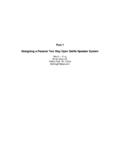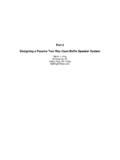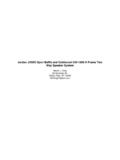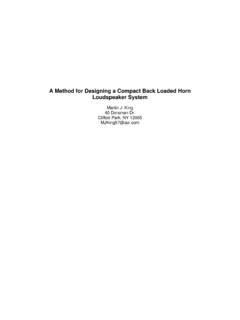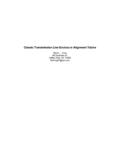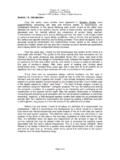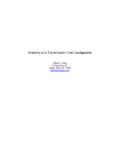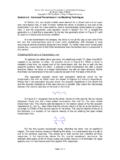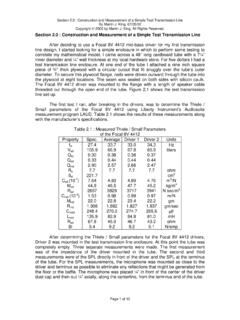Transcription of U and H Frames - Quarter Wave
1 Comparison of the Bass Performance of passive open baffle , U. frame , and H frame Speakers Martin J. King 40 Dorsman Dr. Clifton Park, NY 12065. Comparison of the Bass Performance of passive open baffle , U frame , and H frame Speakers By Martin J. King, 02/25/08. Copyright 2008 by Martin J. King. All Rights Reserved Introduction : My first article on OB design, Designing a passive Two Way open baffle Speaker System, provided some general guidelines for selection of a bass driver and what could be expected in the way of bass performance. The conclusion was that for a passive OB system a high Qts driver that is significantly more efficient then the midrange or full range driver was required to produce a flat SPL frequency response.
2 It was also demonstrated that the natural response hump occurring in open baffle designs could be combined with a low pass crossover to produce an extended bass SPL frequency response. These were the key points for designing the bass section of a passive OB. speaker system. After this initial article was completed, I started thinking about other types of dipole speakers like the popular U and H frame designs. In the past, I had never really spent much time trying to optimize U or H frame designs even though I had generated MathCad worksheets to handle these configurations. Seigfried Linkwitz's Orion(1) and John Kreskovsky's NAO(2) use H and U Frames respectively in their commercial OB.
3 Speaker systems. Both designs use active equalization and active crossovers to produce extended low bass response from drivers typically found in standard box speakers. I did not find a passive U or H frame dipole speaker on the Internet so I began wondering what would be required to design such a system. Finally the light bulb went on when I realized that the U and H frame geometries do not augment the bass like a typical box speaker, they behave as a dipole in a similar manner as the OB but in a more compact package. This realization and my experience with passive OB designs made me wonder how the U and H frame dipoles would perform if I used my favorite OB driver, the Eminence Alpha 15A.
4 This article documents my findings. Skipping Right to the Results : Before getting into all of the design trade-offs, let's look at the results I was able to achieve. Figure 1 shows the SPL response for the OB, U frame , and H frame using an Eminence Alpha 15A driver. The SPL responses were calculated at a 1 m distance and 32 inches above the floor (the same location as the previous article). The goal in each design was to produce a smooth bass SPL response and cross over to a suitable midrange or full range driver at approximately 200 Hz. Looking at the three response curves, you can see that going from OB to U frame and then to H frame results in increased bass extension but at the expense of reduced SPL.
5 Table 1 shows the results I used to characterize the bass performance of these three design options. Table 1 : SPL and -3 dB Frequency Design SPL f3. OB 41. U frame 32. H frame 28. Units dB Hz Note, 90 dB was chosen for the OB since it is the SPL value just above the onset of the OB induced bass roll-off. Page 1 of 10. Comparison of the Bass Performance of passive open baffle , U frame , and H frame Speakers By Martin J. King, 02/25/08. Copyright 2008 by Martin J. King. All Rights Reserved Figure 1 : Calculated SPL Response for OB, U frame , and H frame Designs Page 2 of 10. Comparison of the Bass Performance of passive open baffle , U frame , and H frame Speakers By Martin J.
6 King, 02/25/08. Copyright 2008 by Martin J. King. All Rights Reserved So now the obvious discussion concerns what trade-offs were made to produce these SPL response plots. The following section will examine each end of the SPL. response curves highlighting the geometric dimensions used to produce the bass roll-off and then the impact on the SPL frequency response of the specified crossover frequencies. Geometry Definitions : As described in the previous article, the OB is 20 wide, 38 tall, and stands directly on the floor. The Eminence Alpha 15A driver is centered 10 above the bottom edge of the baffle . The full range driver axis was 32 above the bottom edge of the baffle .
7 The U and H frame designs used a common cross-sectional area and cavity depth. The internal cross-sectional area is 16 wide and 16 tall. The depth of the cavity was defined as . The depth was selected to push the first Quarter wavelength resonance above the desired crossover frequency of approximately 200 Hz. Leffective = + x reffective Leffective = + x . Leffective = = m f1/4 = c / (4 x Leffective). f1/4 = 344 m/sec / (4 x m). f1/4 = 262 Hz Adding additional length to either the U or H frame drops the Quarter wavelength resonant frequency resulting in a peaking SPL response around the crossover frequency. Efficiency of the bass output would not be increased with this additional length.
8 The efficiency of a U or H frame could be increased by using a larger cross- sectional area. The depth of U frame or either side of H frame enclosures should be set to place the Quarter wavelength resonance above the selected low pass crossover frequency. At the risk of repeating myself, the SPL responses for all three designs in this study are calculated at a 1 m distance from the front baffle and 32 above the floor. Again, the intent is to calculate the bass contribution to the system SPL response on the axis of a full range or midrange driver positioned approximately at ear level for a seated listener. Page 3 of 10. Comparison of the Bass Performance of passive open baffle , U frame , and H frame Speakers By Martin J.
9 King, 02/25/08. Copyright 2008 by Martin J. King. All Rights Reserved Figure 2 : Geometries of the OB, U frame , and H frame Designs Page 4 of 10. Comparison of the Bass Performance of passive open baffle , U frame , and H frame Speakers By Martin J. King, 02/25/08. Copyright 2008 by Martin J. King. All Rights Reserved Impedance : The electrical impedance of the OB, the U frame , and the H frame are shown in Figure 3. Plotted in each curve is the infinite baffle impedance as a reference. Moving from top to bottom in Figure 3, the OB driver resonance is equal to the infinite baffle value of 41 Hz while the U and H frame resonances drop to 35 Hz and 31 Hz respectively.
10 If we attribute these drops in resonant frequency solely to a portion of the air in each cavity adding parasitic moving mass to the driver cone, the mass of added air can be calculated to be approximately 22 gm. This represents about 60% of the air in each deep cavity. Assuming added mass is the only property contributed by the enclosure near the system resonant frequency, the impact on the Eminence Alpha 15A Thiele / Small parameters can also be estimated. These calculations are shown in Figure 4. The conclusions drawn from Figure 4 are that the added mass drops the system resonant frequency and the SPL/W/m while increasing the effective Qtd.
